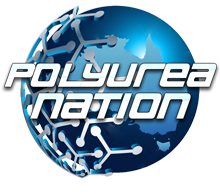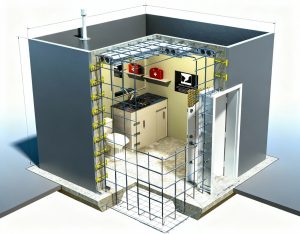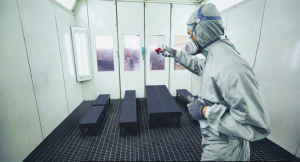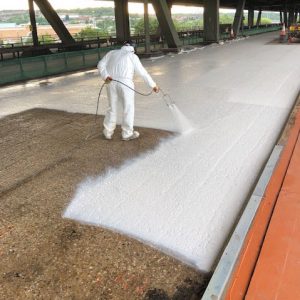Pros & Cons of Using Polyurea for Secondary Containment
Pros
- Polyurea is a fast-setting material, which makes it particularly well-suited for secondary containment projects that require a quick turnaround.
- Polyurea is extremely durable and resistant to chemical and environmental damage, making it an ideal material for secondary containment applications.
- Polyurea is highly flexible, allowing it to adapt to changing temperatures or ground movements without cracking or breaking.
- Polyurea is extremely resistant to corrosion, which is an important factor when using the material for secondary containment.
- Polyurea is resistant to water, which is beneficial in applications where water leakage or flooding may be a concern.Cons
- Polyurea is a relatively expensive material, and may not be suitable for projects with limited budgets.
- Polyurea is not easily repaired, and any damage to the material may require the entire containment area to be re-coated.
- Polyurea is not UV resistant, and may require additional protection in areas that are exposed to direct sunlight.
- Polyurea is not fire resistant, and may be compromised in the event of a fire.
- Polyurea may require additional maintenance to ensure it is not compromised by environmental factors.
Exploring the Different Application Methods for Polyurea for Secondary Containment
Polyurea is a versatile material that is widely used for secondary containment applications. It is strong, durable, and resistant to a wide range of chemicals, making it an ideal choice for protecting against leaks and spills. Polyurea can be applied either by spray, roller, or brush, depending on the size and complexity of the containment area. Each method has its own advantages and disadvantages, and it is important to consider the specific requirements of the job before deciding on an application method.
Spray application is the most common method for applying polyurea to secondary containment areas. It is fast and efficient, and can be used to coat large areas quickly and evenly. The main disadvantage of spray application is that it does not provide the same level of detail as the other methods. Spraying can also be difficult in confined spaces, and require additional safety precautions.
Roller application is the second most common method for applying polyurea. It is ideal for coating large areas, and provides a more even and consistent finish than spray application. The main disadvantage of roller application is that it is more labour intensive than spray application. It also requires more time and effort to achieve a high-quality finish.
Finally, brush application is the least common method for applying polyurea. It is more labour intensive and time consuming than the other methods, but it is the only option for achieving detailed results. Brush application is a good choice for coating irregular surfaces or tight spaces, and it is often used to create decorative patterns on the finished surface.
In conclusion, there are several methods for applying polyurea to secondary containment areas. Each has its own advantages and disadvantages, and it is important to consider the specific requirements of the job before deciding on an application method. With careful consideration, the right application method can ensure that the finished surface is strong, durable, and resistant to leaks and spills.
What You Need to Know Before Applying Polyurea for Secondary Containment
Secondary containment systems are essential for protecting the environment from the risks posed by hazardous substances. Polyurea is a material that can be used in secondary containment systems and offers many advantages over other types of containment systems. However, there are some important considerations that must be taken into account before applying polyurea for secondary containment.
First, it is important to understand the specific requirements of the local regulatory agency that governs the containment system. Different agencies have different regulations and requirements, so it is essential to understand what is required before beginning the application process.
Second, it is important to assess the condition of the surface on which the polyurea will be applied. The surface must be clean and dry in order to ensure proper adhesion of the polyurea. Any cracks, gaps, or other irregularities should also be addressed before application.
Third, the type of polyurea being used must be carefully considered. Different types of polyurea have different properties, so it is essential to select a type of polyurea that is suitable for the intended application.
Fourth, the installation process must be carefully planned and executed. This includes ensuring that the correct equipment is used and that the application is done correctly. It is also important to ensure that the proper safety precautions are taken during the installation process.
Finally, it is important to regularly inspect and maintain the secondary containment system. This includes checking the integrity of the polyurea, looking for signs of wear or damage, and repairing any problems as they arise.
By taking the time to understand the requirements of the local regulatory agency, properly preparing the surface, selecting the appropriate type of polyurea, properly installing the material, and regularly inspecting and maintaining the system, polyurea can be an effective choice for secondary containment systems.
The Advantages of Using Polyurea for Secondary Containment
Secondary containment is an important part of many industrial, commercial, and residential projects. It is designed to protect the environment against the potential leakage of hazardous materials. Polyurea is a versatile material that is increasingly being used for secondary containment systems.
Polyurea is a spray applied elastomeric coating that is made up of two base components, an isocyanate and a resin. It is a strong, fast-drying material that can be used to protect surfaces from corrosion, abrasion, and chemicals. It is also highly resistant to water, oils, and solvents, making it an ideal choice for secondary containment applications.
One of the main advantages of using polyurea for secondary containment is its superior strength. Polyurea is much stronger than other coatings and can withstand high levels of pressure. This makes it ideal for use in storing hazardous materials, as it can contain any potential leaks and prevent contamination of the surrounding environment.
In addition to its strength, polyurea is also highly durable. It is resistant to UV light, moisture, and extreme temperatures, making it ideal for long-term use. It also has excellent adhesion properties, making it easy to install and maintain.
Polyurea is also an economical choice for secondary containment. It is easy to apply, requires minimal maintenance, and is relatively inexpensive compared to other materials. This makes it a cost-effective option for many applications.
Finally, polyurea is a safe material to use for secondary containment. It is non-toxic and does not emit any hazardous fumes, making it safe to use in confined spaces. It is also environmentally friendly, as it does not release any volatile organic compounds (VOCs) into the atmosphere.
In conclusion, polyurea is an excellent choice for secondary containment applications. It is strong, durable, and cost-effective, and it is also safe and environmentally friendly. For these reasons, it is becoming an increasingly popular choice for many projects.
Why Polyurea is the Best Choice for Secondary Containment
Polyurea is an increasingly popular choice for secondary containment systems, and for good reason. It is highly versatile, cost-effective, and offers superior protection against leaks and spills.
Polyurea is a two-component, spray-on elastomeric coating that can be applied to nearly any surface, including concrete, steel, and wood. It cures quickly, forming an impermeable membrane that is both elastic and resistant to cracking. This makes it ideal for secondary containment systems, as it can be applied quickly and easily without requiring any special preparation.
Polyurea is also incredibly durable and can withstand extreme temperatures, corrosion, and mechanical abrasion. This makes it ideal for secondary containment systems, as it can protect against the most extreme conditions. It is also resistant to most chemicals and petroleum products, making it a perfect choice for applications where there is a risk of hazardous materials leaking into the environment.
Finally, polyurea is an economical choice for secondary containment systems. It requires minimal maintenance and is relatively inexpensive compared to other containment options. It is also easy to repair if the containment system is ever breached, making it a cost-effective solution in the long run.
In short, polyurea is an ideal choice for secondary containment systems due to its versatility, durability, and affordability. It offers superior protection against leaks and spills and is easy to maintain and repair. For these reasons, polyurea is quickly becoming the go-to solution for many companies and industries.
How to Choose the Right Polyurea Application Method for Secondary Containment
Secondary containment is an important aspect of environmental protection and safety. It is a process of containing a hazardous material in the event of a spill or other accidental release. This involves the use of a secondary containment system, which can be made of concrete, plastic, or other materials. Polyurea is a popular option for secondary containment systems due to its durability and flexibility. However, selecting the right method for applying polyurea to a containment system is essential to ensure long-term performance.
When selecting the right application method for polyurea, it is important to consider the type of containment system being used and the environment in which it will be placed. For example, if the system will be exposed to extreme temperatures or moisture, a low-pressure spray-applied method may be more suitable. On the other hand, if the system will be located in an area with minimal environmental exposure, then a hand-applied method may be more appropriate.
In addition to the environmental conditions, the size and shape of the containment system must also be taken into account when selecting an application method. For example, hand-applied methods are more suitable for small containment systems, whereas larger systems may require the use of a high-pressure spray-applied method. It is also important to consider the desired thickness of the polyurea coating, as this will determine the application method and the number of coats required.
Finally, it is important to select an application method that is reliable and cost-effective. Low-pressure spray-applied methods are generally more cost effective than hand-applied methods, although they may require more time and labor to complete. Conversely, hand-applied methods may be more expensive, but they can often be completed in a shorter amount of time.
Choosing the right application method for polyurea secondary containment systems is essential to ensure long-term performance and cost-effectiveness. By taking into account the type of containment system, the environmental conditions, the size and shape of the system, and the desired coating thickness, it is possible to select an application method that is both reliable and cost-effective.
Comparing Polyurea Application Methods for Secondary Containment
Secondary containment is a vital part of many industries, including those involving chemicals and hazardous materials. The purpose of this containment is to prevent the escape of these materials into the environment should a catastrophic event occur. Polyurea is a type of coating that is often used in secondary containment systems. It is known for its excellent properties, such as fast-curing, chemical resistance, and durability.
When it comes to applying polyurea for secondary containment, there are two primary methods: spraying and brushing. Both of these techniques have their own advantages and disadvantages.
Spraying is the most common method of application for polyurea. It is fast and efficient, and it offers a uniform coating with minimal effort. However, it is not always suitable for large surfaces, as larger areas require more time and materials. It can also be difficult to apply in tight corners or other difficult-to-reach areas.
Brushing is a slower process but is often preferred for larger surfaces. It is also the preferred method for applying polyurea in hard-to-reach areas. This method is more labor-intensive, but it also offers better control over coverage and thickness.
When deciding which application method to use for secondary containment, it is important to consider the size of the area to be covered, as well as the desired finish. For smaller areas, spraying is the most efficient option, while larger surfaces may require brushing. It is also important to consider the ease of access to the containment area, as some areas may be difficult to reach with a spray gun.
Ultimately, when it comes to applying polyurea for secondary containment, there is no one-size-fits-all solution. Each job requires careful consideration to determine which application method will provide the most efficient and effective results.






